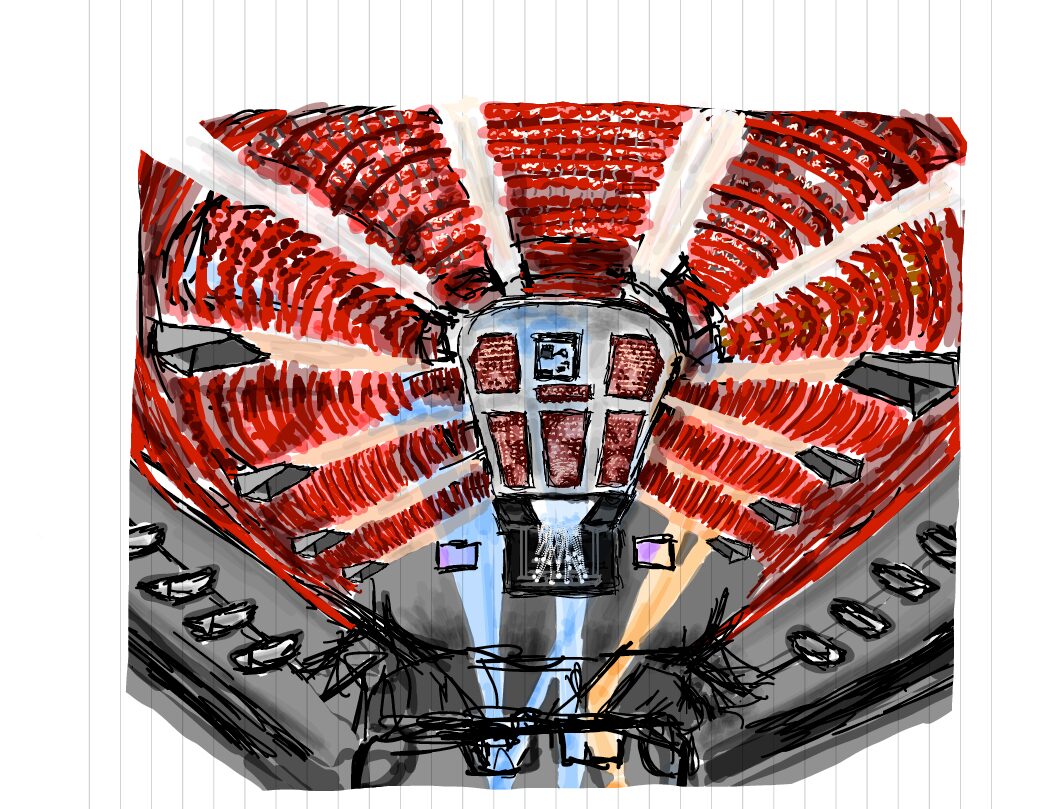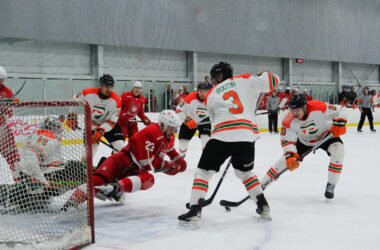Who invented the slapshot? If you answered Bernard Geoffrion of the Montreal Canadiens in the 1950s, you are mistaken. The correct answer is Eddie Martin of the Halifax Eureka in 1906. Who was the first goalie to drop to a knee in order to stop a puck? If you thought it was Ottawa Sentator’s Clint Benedict you are again, incorrect. It was actually Henry Franklin. Now, as you might be tempted to open another tab on your computer to Google “What league were the Halifax Eureka in” or “Henry Franklin hockey,” pick up a copy of Black Ice: The Lost History of the Colored Hockey League of the Maritimes, 1895-1925 by Darril Fosty and George Fosty—it will likely save you some time.
The Fosty brothers’ 2007 book delves into the history of the Coloured Hockey League of the Maritimes (CHL). Founded in Halifax, Nova Scotia, the league was organized by Black Baptists and Black intellectuals in 1895 and became a driving force in the push for equality for Black Canadians. However, like much of Black history in Canada, the CHL is purposefully erased from Canadian historical memory to serve white supremacy.
“As [many] Black Canadian scholars argue, Black people are an absented presence in Canada,” Debra Thompson, a professor in McGill’s Department of Political Science, explained. “Black people are absented or purposefully erased from Canadian history, but also present in that so much of Canadian history is about presenting Canada as being the Promised Land.”
Vinay Virmani––a producer working with UNINTERRUPTED Canada––embarked on Black Ice, the documentary, drawing on the Fosty brothers’ book. Charles Officer, a Canadian documentary filmmaker who passed away earlier this year, reached out to Hubert Davis to suggest he take on the project. Davis, an alumni of the McGill varsity basketball team, did not have a background in hockey, however, he viewed directing Black Ice as a “Trojan horse.” Davis hoped to use hockey as a catalyst to explore the Black experience in Canada, by delving into the history of the CHL and its descendants, alongside gathering testimonies from both current and former hockey players in Canada.
The documentary focuses on the CHL and the Black community that lived in Africville, where one of the teams––the Africville Seasides––were based, until the city of Halifax forcibly relocated its residents and destroyed the community’s infrastructure in the 1960s.
“[The people who lived there] have such love for this place and this idea of community, […] I feel like that was something that kind of got lost in the Black experience in Canada,” Davis told The Tribune. “When things dispersed, like when people had to leave for economic reasons or systemic racism […] I think they lost some of that identity of who, or what, community builds […] [W]hen you look at a lot of other cultures that have been able to keep that intact, they still have this sense of belonging and place and I think we, unfortunately, lost that in Canada.”
The documentary highlights how white Canadian media undermined Black hockey culture and the quality of play in the CHL to maintain white dominance of the sport, despite the CHL’s success. The CHL, achieving great popularity in the late 1800s and early 1900s, consistently attracted more than 100 fans to its games and generated sufficient gate revenue to compensate its players. Hoping to gain access to part of the revenue, white teams in Halifax requested to play exhibition games against CHL teams, breaking the colour barrier. However, cartoons in the Sydney Post portrayed Black players as violent, unsportsmanlike, and unskilled, leading to a diminished interest among white fans in paying to see them play.
Understanding the history of systemic racism and its active role in belittling the skill of Black hockey players spoke to Davis’ goal of fleshing out the historical context in which racist incidents occur today.
“It’s really hard to understand a problem without having a bigger context,” explained Davis. “[When] you [go] back and look at the history of hockey, [you see the] Black experience has always been tied to hockey [and] you realize how ridiculous the whole thing is. How absurd it is [to claim] Black people don’t belong in hockey when they are some of the pioneers of the sport.”
Yet, as highlighted through testimony from players such as Blake Bolden and Akim Aliu, systemically racist perceptions of Black players as being “uncoachable” continue to strip Black players of opportunities to excel.
“When I started reading the stories about some of the current-day players, what was going on with them, I was still a bit taken aback,” Davis continued. “I was a little bit shocked at just how brazen some of the incidents were and how, and [….] it seemed like it was kind of glossed over a lot of times.”
While on an individual-team basis, the Montreal Canadiens and the Toronto Maple Leafs demonstrated support for the documentary, Black Ice has largely been neglected by the mainstream professional hockey community. Davis explained in taking on the project, some hockey insiders warned him that the documentary would likely not go over well with the National Hockey League (NHL).
“As a documentary filmmaker, to make something that is specifically about a sport and then be told what you should or shouldn’t say is always a very curious thing to me,” Davis said.
However, given the NHL’s unwillingness to collaborate with the Hockey Diversity Alliance––an organization that many of the players in the film are members of––on a number of fronts, their lack of acknowledgment of the documentary itself is unsurprising.
While the sport is moving in a better direction in terms of inclusivity, Thompson explained that practices of predatory inclusion are commonplace in hockey. The term predatory inclusion, as popularized by Keeanga-Yamahtta Taylor in her book Race for Profit, is used to describe instances when marginalized communities are included in spaces they were historically excluded from on exploitative and predatory terms. While Taylor uses the term to describe the way in which Black people were included into the real estate market after explicitly racist housing policies came to an end, Thompson explored how it can be applied to hockey.
“In the film, I use predatory inclusion to talk about the ways that Black people are so frequently included in these institutions, often for-profit […] [in ways] that are ultimately quite harmful,” Thompson said. “Nobody ever asks what happens after we are included, what are our lives like? What violence do we face? What if being included is itself violent, dangerous, predatory, exploitative?”
Many point to the NHL’s “Hockey Is For Everyone” campaign as an example of the hypocritical nature of rhetorics of inclusion in hockey. However, Thompson believes that initiatives like these can be reconceptualized in a more positive light.
“In another interpretation of [Hockey Is For Everyone], it can be seen as a normative assertion,” Thompson said. “In order to make that normative assertion, more genuine and less hypocritical, what we want to see from leagues from institutions for organizations is a genuine, concerted effort to ensure that teams are not racist, that these environments are not harmful for Black folks and other people of colour.”
For Thompson, this more hopeful conception allows for a symbiotic relationship between initiatives at the professional level and their realized impact at the youth level.
“We see youth leagues that are not toxic, and that are promoting the same kind of egalitarian values that the leagues are promoting at the other end. That’s kind of the hopeful thing,” Thompson said. “Things can be hypocritical and hopeful at the same time.”
To draw out this connection, the documentary spotlights Seaside Hockey, a local youth hockey program in Toronto named after the Africville Seasides. The program was co-founded by Kirk Brooks, his son and current Arizona Coyotes skill development coach Nathaniel Brooks, and former NHL player, Anthony Stewart. In the documentary, Kirk discusses his relationship to hockey and the mission of Seaside.
“What I loved about [Kirk] is that he was like this representation that the Black experience in hockey has always been present,” Davis explained. “He grew up playing hockey, it’s part of his life and he had always known about the Coloured Hockey League so none of these stories were a surprise to him [….] Going back to Herb Carnegie and Willie O’Ree and all these [players], there’s always actually been a presence. Not all of them are well known or famous, but a lot of them have been behind the scenes and I think Kirk represented that.”
For Davis, gaining insight into those with generational knowledge about the Coloured Hockey League, including interviewing descendants of former players, provided him with a “certain kind of pride.” Despite tackling harrowing stories of racism told by a number of former and current players including Saroya Tinker, Wayne Simmonds, Willie O’Ree, and Matt Dumba, Black Ice illustrates this very pride felt by many players by putting their love for hockey on display.
“I didn’t play hockey and by the end of the documentary, I kind of wish that I had,” reflected Thompson. “Black Ice really captures the complexity of Black livingness because in a world that focuses so much on Black death, and destruction and domination, to emphasize that like we are here, we’re still here, we’re still doing this and there are beautiful things that remain about this incredible game.”
Black Ice will be screened at Taverne 1909 near the Bell Centre on Feb. 20 at 6:00 p.m.. Tickets can be reserved online free of charge.








